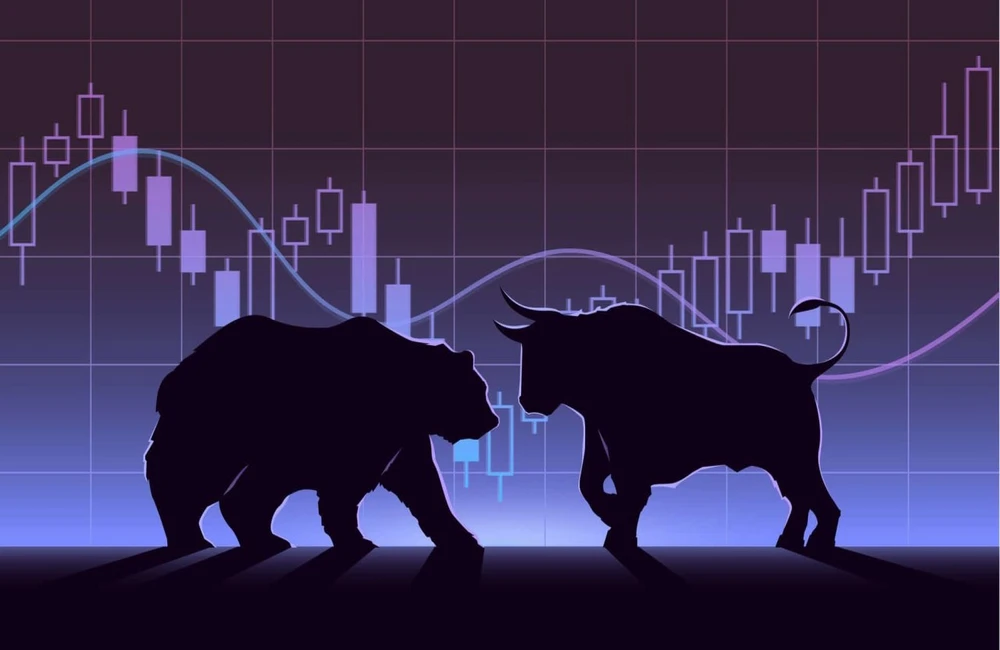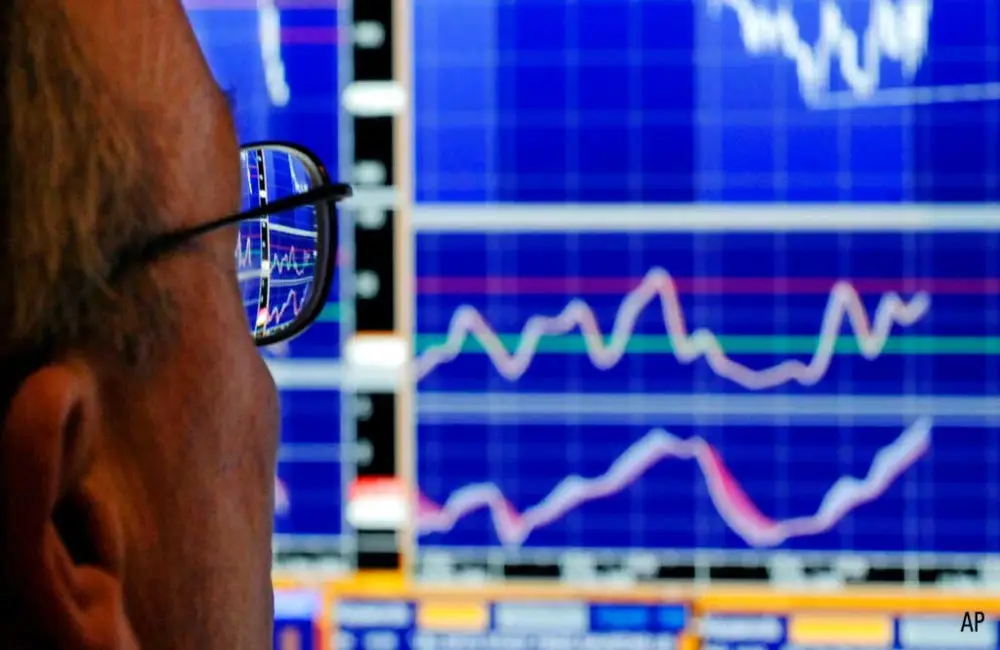ASX futures gained 10 points, or 0.1 per cent, to 7506 by 8:00. This coming week starts the shorter trading week higher at 9:00 on Tuesday.
The S&P 500 ended down 0.90 point, less than 0.1%. The Dow Jones Industrial Average fell 39.54, or 0.1%. The tech-heavy Nasdaq Composite Index fell 18.72 points, or 0.1%. All three indexes swung between small gains and losses in a light-volume session.
US bond markets fell again Monday, unwinding a short-lived rally registered earlier in the week. The yield on the 10-year Treasury note rose to 2.861 percent, closing at its highest level since December 2018. The benchmark yield has jumped more than half a percentage point just in April. Bond yields and prices go in opposite directions.
The rout in Treasurys has been surprising, because yields have already risen to levels that appear attractive to long-term investors such as pension funds and foreign governments, said Jimmy Lim, the founder of Modular Asset Management, a macro hedge fund in Singapore. “Inflation is a very real concern. There’s a little bit of a buyers’ strike going on,” he said.
Investors are looking to the current US reporting season for clues on the effect of inflation on corporate profits. Bank of America rose on Monday after the bank beat analysts’ profit estimates. ‘Streaming giant’ Netflix, which has had a bumpy ride, reports on Tuesday (Wednesday morning AEST) and retail darling Tesla the day after.
In a late-night TV address on Monday (Tuesday morning AEST), Ukrainian president Volodymyr Zelensky separately said Russia had launched its long-debated new offensive into the country’s eastern Donbas region.
Locally, the S&P/ASX 200 finished 0.6% better at 7523.4 last Thursday ahead of a four-day Easter break. The benchmark index climbed 0.6% for the week, after the latest figures showed the jobless rate held steady.
Energy and technology stocks were the standout performers, both closing 1.3% higher, but financial stocks acted as a drag, ending the day 0.3% lower.
Megaport was up 4.6% and Xero added 2.0%. Northern Star and James Hardie rose 4.2 percent and 3.4 percent.
The biggest loser on the day was regional lender BOQ, down 6.3% despite a 38% lift in half-year profit, with the major banks closing the day down between 0.1% and 0.7% on the day.
In commodities, iron ore added 0.7% to US$153.85 per tonne; gold futures gained 0.6 per cent to $1,986.40; and Brent crude oil added 1 per cent to US$112.84 as the shutdown of an oil field in Libya added to worries about an undersupplied market.
In bond markets, the Australian 10 Year yield fell to 2.97%.
As of 8:00am, compared with the last close of 73.46. The WSJ Dollar Index, which measures the US dollar against 16 other currencies, rose to 93.13.
Asia
Chinese stocks closed mixed, as investors were cautious despite better-than-expected official 1Q23 GDP data from the country. The benchmark Shanghai Composite Index dropped 0.5% to 3195.52, the only loser of the three major indexes. The Shenzhen Composite Index inched up 0.4% to 2022.52 and the ChiNext Price Index added 1.1% to 2487.77.
Among the biggest gainers were electronics makers, including semiconductor companies and telecom equipment suppliers. But the gains were countered by declines in property developers and property management companies.
“Investors are still concerned that the extensive lockdowns and supply-chain disruptions will hurt China’s economy,” said Eric Khaw, a senior portfolio manager at Nikko Asset Management. “China is now experiencing one of the most serious if not the most serious economic challenges since the global financial crisis, and the underlying cause is the zero-Covid policy,” he said.
Last Friday, the central bank of China eased a major constraint on bank lending while leaving benchmark interest rates unchanged. Beijing has not “put out enough policy response to offset the damage” to its economy in the first half of this year, said Dan Fineman, Credit Suisse’s co-head of equity strategy for Asia Pacific.
Gains among auto makers propelled Hong Kong shares, which ended the day in the positive; China’s State Council said it will help new-energy-vehicle consumption and remove car-purchasing restrictions, according to KGI Securities analysts in a research note.
Shares of Geely Automobile and BYD rose 5.2% and 4.7%, respectively. Other gainers were Haidilao, Country Garden Services and Li Ning which gained 10%, 6.5% and 5.7% respectively. The Hang Seng Index closed up 0.7% at 21518.08.
Japanese shares finished down as downturns in chemical and food stocks weighed despite concerns about the higher prices of commodities and raw materials persisting. Nippon Paint Holdings fell 4.0% and food firm Ajinomoto tumbled 3.1%. Elsewhere, Credit Saison soared 21% after activist investor City Index Eleventh reported a 5.1% stake in the credit card firm. The Nikkei Stock Average declined 1.1% to 26799.71.
As the war in Ukraine and Covid-19 lockdowns in China continued to disrupt supply chains, investors remained focused on the issue.
Europe
European markets were shut since Friday for the Easter public holidays.
North America
US stocks ended Monday’s session lower, and the 10-year Treasury yield extended its big gains after a three-day holiday weekend.
The S&P 500 fell 0.90 point, or less than 0.1 percent. The Dow Jones Industrial Average fell 39.54, or 0.1%. The technology-heavy Nasdaq Composite Index fell 18.72, or 0.1%. The three indexes toggled between small gains and losses over the course of the day.
U.S. government bonds fell anew, pushing the yield on the 10-year Treasury note to 2.861%, its highest closing level since December 2018. The benchmark yield is up more than half a percentage point this month alone. Bond yields and prices work in opposite directions.
It is a little surprising the rout in Treasurys remains, since yields have already surged to levels that look attractive to long-term investors like pension funds and foreign governments, said Jimmy Lim, the founder of Modular Asset Management, a macro hedge fund based in Singapore.
“The inflation fear is a real one. There is a little bit of buyers’ strike going on,” he added.
Markets are pricing in more-severe interest-rate increases in coming months by the Federal Reserve, which is attempting to reduce high consumer-price inflation without derailing economic growth.
Investors view the Fed as “behind the curve” in addressing inflation, according to Frances Cheung, a rates strategist at OCBC Bank. The central bank is widely expected to raise rates half a percentage point at each of its next two policy meetings, in May and June, after lifting them a quarter percentage point in March and bringing its benchmark federal-funds rate to a range between 0.25% and 0.5%.
This week, investors will be focusing on corporate earnings. Netflix reports on Tuesday, followed by investor darling Tesla on Wednesday. Other companies scheduled to release financial results this week include Johnson & Johnson, Snap and United Airlines.
Corporate earnings will reflect how companies are navigating inflation and which businesses are better positioned to pass higher prices to consumers, said Katie Nixon, chief investment officer for wealth management at Northern Trust.
“It is going to be pretty intense pricing pressure,” Ms. Nixon said. “All eyes are going to be on margins.”
Bank of America gained $1.28, or 3.4 percent, to $38.85 after the bank reported first-quarter profit on Monday that exceeded analysts’ estimates. Charles Schwab shares dropped $7.81, or 9.4 percent, to $74.94, the S&P 500’s worst-performing stock after its earnings fell below expectations and trading activity declined compared with the same quarter last year.
Shares of Twitter surged $3.37, or 7.5 percent, to $48.45. Rumors of a buyout of the social-media company have continued despite plans for a so-called poison pill provision, which it adopted on Friday, to make it harder for billionaire Elon Musk to raise his stake in the company. Mr. Musk made an unsolicited $43 billion bid to purchase Twitter last week.
In commodities, global benchmark Brent crude futures rose 1.3% to settle at $113.16 a barrel as a shutdown of an oil field in Libya added to concerns that the market is undersupplied. Futures on the US benchmark, West Texas Intermediate, or WTI, rose 1.2% to $108.21 a barrel.
























